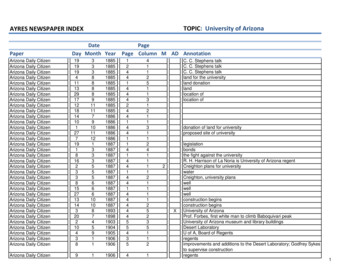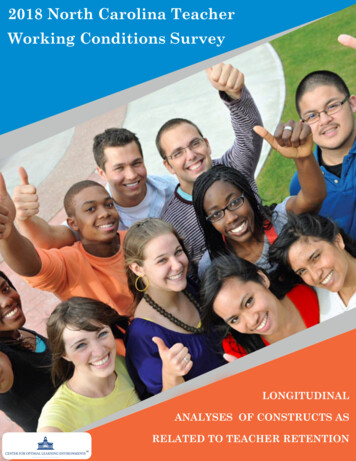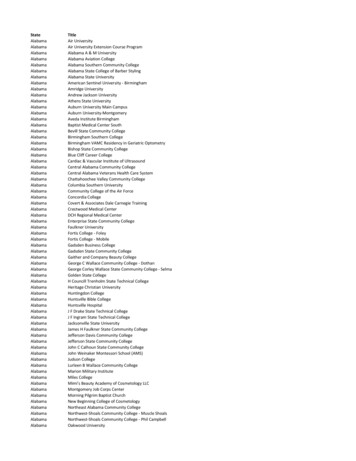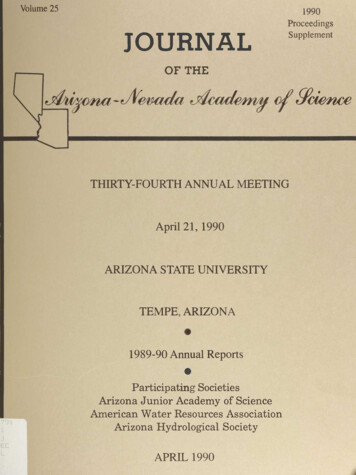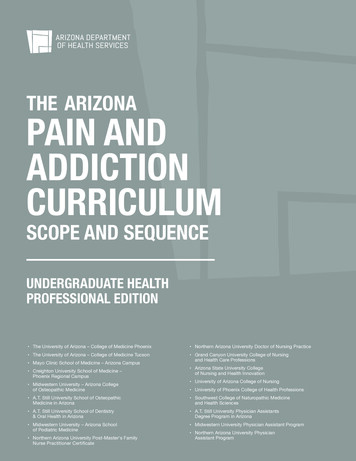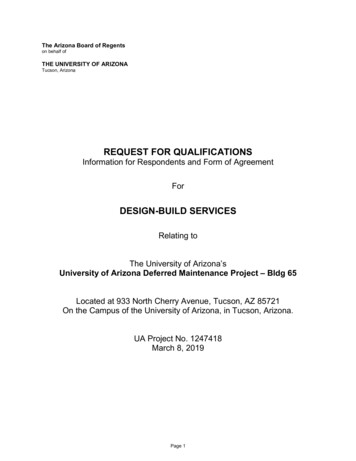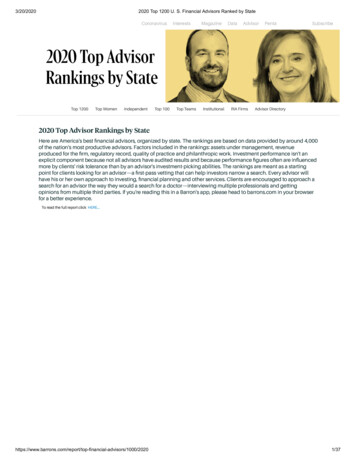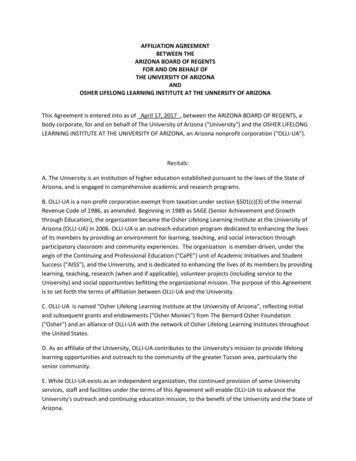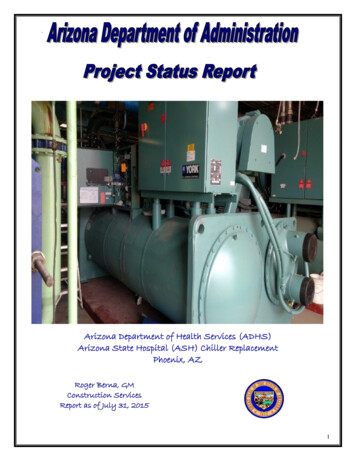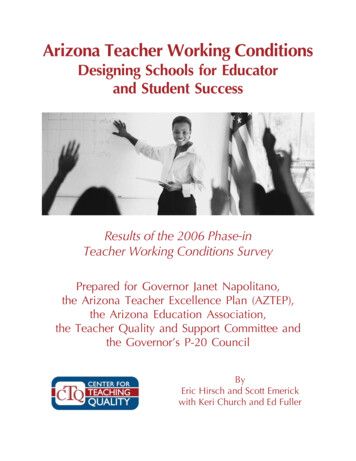
Transcription
iIntroductionArizona Teacher Working ConditionsDesigning Schools for Educatorand Student SuccessResults of the 2006 Phase-inTeacher Working Conditions SurveyPrepared for Governor Janet Napolitano,the Arizona Teacher Excellence Plan (AZTEP),the Arizona Education Association,the Teacher Quality and Support Committee andthe Governor’s P-20 CouncilByEric Hirsch and Scott Emerickwith Keri Church and Ed Fullerwww.teachingquality.org
iExecutive SummaryArizona TeacherWorking ConditionsDesigning Schools for Educatorand Student SuccessResults of the2006 Phase-in TeacherWorking Conditions SurveyPrepared for Governor Janet Napolitano,the Arizona Teacher Excellence Plan (AZTEP),the Arizona Education Association,the Teacher Quality and Support Committee andthe Governor’s P-20 CouncilByEric Hirsch and Scott Emerickwith Keri Church and Ed Fullerwww.teachingquality.org
iiArizona Teacher Working Conditions: Designing Schools for Educator and Student SuccessThe Center for Teaching Quality improves student learning through developing teacher leadership, conducting practical research and engaging various communities. To accomplish thismission, the Center for Teaching Quality strives to shape policies that ensure: Students, no matter what their background or where they go to school, are ready to learn;with Teachers who are caring, qualified, and competent with vast content knowledge and theability, through quality preparation and ongoing development and support, to ensure thatall children can learn; in Classrooms that have adequate resources and provide environments conducive to studentlearning; in Schools that are designed to provide teachers with sufficient time to learn and work together in collaboration with a principal who respects and understands teaching; in Districts that have policies and programs that support the recruitment, retention and development of high quality teachers in every school; in States that have well-funded systems that include rigorous preparation and licensing withevaluation tools that ensure performance based standards are met; in a Region that works collaboratively, using common teaching quality definitions, sharing data,and working across state lines to recruit, retain and support high quality teachers; in a Nation that views teaching as a true profession and values teachers as one of its most important resources.Center for Teaching Quality
iiiExecutive SummaryTable of ContentsList of Tables and Figures . ivAcknowledgments . vExecutive Summary . viiIntroduction . 1Methodology . 2About the Participants and Respondents . 2Major Findings . 41. Teacher Working Conditions Are Correlated with Student Achievement . 42. Teacher Working Conditions Influence Teacher Employment Plans . 113. Teachers and Administrators View Working Conditions Differently . 154. Schools Vary in the Presence of Teaching Working Conditions . 175. Arizona Teachers Are More Negative About Working Conditions than Thosein Some Other States . 18Domain Analyses . 20Time: Ensuring Arizona Teachers Have the Opportunity to Work Collaborativelyand Reach All Students . 20Facilities and Resources: Ensuring Teachers Have the Resources to Help All Children Learn . 22Leadership: Ensuring Schools Have Strong Leaders Who Support Teaching and Learning . 23Empowerment: Ensuring Those Who Are Closest to Students Are Involved in MakingDecisions that Affect Them . 24Professional Development: Ensuring Teachers Can Continually Enhance TheirKnowledge and Skills . 25Induction and Mentoring: Ensuring that New Teachers Receive Sufficient Supportto Be Successful and Stay in Teaching . 27Recommendations . 301. Expand the Initiative Statewide in Spring 2007 . 302. Ensure the Data from the Phase-in Is Used by Educators and Develop Assistancefor Working Conditions Reform to Be Available When Statewide Data Is Released . 313. Invest in School Leaders Who Can Create Positive Teacher Working Conditions . 324. Invest Substantially in Teacher Support . 32Notes . 34www.teachingquality.orgiii
ivArizona Teacher Working Conditions: Designing Schools for Educator and Student SuccessList of Tables and .17.18.Participating Districts and Survey Response Rates . 3Correlation Between Working Conditions and 5th Gradate AIMS Results in Math,Reading and Writing . 6Correlation Between Working Conditions and 8th Gradate AIMS Results in Math,Reading and Writing . 8Correlation Between Working Conditions and 10-12th Gradate AIMS Results inMath, Reading and Writing . 9Influences on Teachers’ Future Employment Plans . 12Perceptions of Teachers Staying, Moving, and Leaving . 13Correlations Between Working Conditions and Future Employment Intentions . 14Correlations Between Top Questions and Intent to Stay . 15Differences in the Perception of Teachers and Administrators of Teacher WorkingConditions . 16Perception of Teachers and Administrators About Leadership Addressing WorkingConditions Concerns . 17Differences Between Title II and Other Participating Schools . 18Percentage of Teachers Agreeing With Working Conditions Questions in Arizonaand Other States . 19Time Spent Outside of the School Day on School-Related ActivitiesDuring an Average Week . 21Percentage of Teachers Agreeing with Facilities and Resources Questions . 22Teachers’ Role in School Decision Making . 24Amount of Professional Development Received and Perceptions of Where Greater SupportIs Necessary . 26Effectiveness of Mentoring in Providing Support to New Teachers . 27Frequency of Mentoring Activities According to Mentors and Mentees . 28Figure1.2.3.4.5.ivAspect of Working Conditions Teachers Believe Is Most Important to Student Learning . 5Future Employment Plans of Arizona Teachers . 11Aspect of Working Conditions Teachers Believe Is Most Important to ContinueTeaching in Their School . 13Non-instructional Time Available During the School Day in an Average Week . 21Perception that the Faculty Has an Effective Process for Making Group Decisions andSolving Problems . 25Center for Teaching Quality
vExecutive SummaryAcknowledgmentsFunding for the Phase-in Arizona Teacher Working Conditions Survey came from the ArizonaTeacher Excellence Plan (through a federal Title II Higher Education Act grant), the NationalEducation Association and the Arizona Education Association.CTQ could not have conducted the Teacher Working Conditions Initiative without the leadership of the Office of Governor Janet Napolitano. CTQ would especially like to thank BeckyHill, the Governor’s Education Policy Advisor, whose support was instrumental in coordinatingand moving this effort forward. Jennifer Bowser, formerly an assistant to Becky Hill provideddaily support, coordinated the help desk and completed everything necessary to ensure theinitiative was a success. The Arizona Education Association, particularly Vice President Andrew Morrill, provided tremendous financial and intellectual support throughout the initiativeand was essential in attaining the high participation rates amongst educators.Participating district representatives and stakeholders provided helpful guidance throughout.The superintendents who helped coordinate the dissemination survey codes and encouragedtheir educators to complete the survey ultimately made this initiative a success. The leadership, administrators and educators in the Gilbert Unified School District, Creighton Elementary District, and the Safford Unified School District, where more than 90 percent of educatorsparticipated in the survey, were particularly successful in their survey efforts.We would also like to thank our partners in completing this project. Phil Kaufman and ChrisAndrews at LearnNC hosted the on-line survey and provided data reports for all eligible schools.Ed Fuller consulted with CTQ to help organize and manage the data and also provided virtually all statistical analyses throughout the report.Most importantly, we would like to extend our sincere appreciation to the almost 5,000 dedicated educators who were willing to share their time and input with us while they continuestriving to ensure that their students achieve at the highest levels.www.teachingquality.orgv
viArizona Teacher Working Conditions: Designing Schools for Educator and Student SuccessCenter for Teaching Quality
viiExecutive SummaryExecutive SummaryEmerging research from across the nation demonstrates that school working conditions—time,teacher empowerment, school leadership, professional development, and facilities and resources—are critical to increasing student achievement and retaining teachers.The existing national data regarding the impact of working conditions on student achievementand teacher turnover provided a meaningful impetus for 18 Arizona districts to collect andanalyze data to inform local working condition reform strategies as part of a state Phase-inworking conditions initiative.Governor Janet Napolitano, the Arizona Education Association, the Arizona Teaching ExcellencePlan (AZTEP) partnership, the leadership in 18 school districts and other stakeholders conducted the survey to provide information that can be used for data-driven school improvementplanning, faculty conversations and consideration of district and school policies and programs.By placing the perceptions of Arizona educators at the center of school and district efforts toimprove teacher recruitment and retention, the ultimate goal of the initiative is to help create astable teaching force that allows for a high quality teacher in every classroom across the state.Analysis of the approximately 5,200 survey responses (representing over 70 percent of educatorseligible to participate in the survey) demonstrates that working conditions are correlated withAIMS results in math, reading and writing as well as teachers’ future employment plans. Of thevarious data implications from the survey, five primary findings are highlighted in this report:1. Teacher Working Conditions are Correlated with Student AchievementThe overall findings from the analysis regarding the impact of working conditions on student achievement provide evidence to support the notion that teacher working conditionsare student learning conditions. The analyses specifically point to the need to provide safe,trusting environments with sufficient instructional resources for all teachers to be successful.2. Teacher Working Conditions Influence Teacher Employment PlansStatistically significant correlations between working conditions and teachers’ desire to staywere found for all working conditions. Connections are particularly strong for the conditions of school leadership and empowerment.3. Teachers and Administrators View Working Conditions DifferentlyThere are considerable gaps between the perceptions of teachers and administrators regarding the degree to which school leadership addresses teacher concerns. While some discrepancies might be expected between administrators and teachers on a measure of leadershipwww.teachingquality.orgvii
viiiArizona Teacher Working Conditions: Designing Schools for Educator and Student Successeffectiveness, the degree of these discrepancies is startling and must be taken into consideration for any working conditions reforms to be successful.4. Schools Vary in the Presence of Teacher Working ConditionsThe greatest differences in teacher perceptions of working conditions appear across schools.Basic differences between teachers themselves appear to make limited difference in howthey perceive working conditions. Teachers, regardless of gender, education, race, ethnicity,and even years of experience, view working conditions similarly. However, there are differences between elementary, middle and high schools as well as AZTEP and non-AZTEPschools.5. Arizona Teachers are More Negative about Working Conditions than Teachers in OtherStatesIn general, Arizona educators were more likely to note the presence of positive workingconditions than those in Clark County, Nevada (Las Vegas) and Ohio (about one-third ofrespondents are from Columbus and Cleveland), but less so than their peers in Kansas andNorth Carolina. Of particular importance is that Arizona educators have the most negativeperception about their faculty being committed to helping every student learn (10 percentlower than the next closest state/district).More in-depth analysis of each of the five working conditions areas (along with mentoring andinduction) is also provided within the body of this report.RecommendationsFrom these findings and the domain analysis, recommendations for Arizona educators andpolicymakers are offered to enhance efforts to improve teacher working conditions.1. Expand the Arizona Teacher Working Conditions Initiative Statewide in Spring 2007.2. Ensure the Data from the Phase-in Is Used by Educators and Develop Assistance for Working Conditions Reform to Be Available When Statewide Data is Released.3. Invest in School Leaders Who Can Create Positive Teaching and Learning Conditions.4. Invest Substantially in Teacher Support.The data available from the Phase-in Arizona Teacher Working Conditions Initiative and acrossthe nation indicate that improving these teaching and learning conditions is a critical step toimproving schools. Significant correlations between working conditions, AIMS performanceand teacher employment decisions were documented in the Phase-in initiative.Arizona educators must have the resources and support they need to serve all students well.Without comprehensive, sustained efforts to analyze and improve teacher working conditions,notable efforts to improve student learning and retain teachers cannot be fully successful.Center for Teaching Quality
1IntroductionIntroduction“This is a critical step in my goal to ensure Arizona educators are receiving the necessary toolsto succeed and to create a thriving learning environment. I am pleased with the overwhelming response to this survey and will keep the results in mind as I continue efforts to improveArizona’s education system.”—Governor Janet NapolitanoFor virtually any business or organization, the conditions in which employees work drive theirsatisfaction and productivity. Unfortunately, many schools across the country face persistentteacher working condition challenges that are closely related to high teacher turnover rates andchronic difficulties in recruiting and retaining teachers. Turnover comes at great expense, bothin the negative cumulative effect on student achievement, and as a financial drain to the stateand districts that repeatedly prepare, recruit, and support teachers for the same position.National research demonstrates the importance of addressing school conditions to improveteacher retention. Teachers who leave schools cite an opportunity for a better teaching assignment, dissatisfaction with support from administrators, and dissatisfaction with workplace conditions as the main reasons why they seek other opportunities.1 Surveys of teachers indicatethat a positive, collaborative school climate and support from colleagues and administrators arethe most important factors influencing whether they stay in a school. In national surveys,teachers identified excessive workload, lack of time, and frustration with reform efforts as areasin need of focus and reform.2Addressing these working conditions and building a sense of trust in schools are critical factorsin reforming schools, as both have been linked to greater teacher effectiveness.3 Center forTeaching Quality (CTQ) research examining working conditions survey results in both NorthCarolina and South Carolina demonstrates that teacher working conditions have a significantimpact on student achievement and teacher retention.4One of the most extensive examinations of working conditions data revealed “a clear but difficult lesson: if we want to improve the quality of our teachers and schools, we need to improvethe quality of the teaching job.”5While existing national data on teacher turnover and working conditions is helpful, communities need customized data from their own schools and communities to effectively inform localreform strategies. It is with this in mind that Governor Napolitano, The Arizona TeacherExcellence Plan and the Arizona Education Association have collectively responded to thispressing need for local data results by conducting a “Phase-in” survey to document the perceptions of Arizona educators regarding their working conditions. Participating districts and stakewww.teachingquality.org1
2Arizona Teacher Working Conditions: Designing Schools for Educator and Student Successholders designated this initiative as a Phase-in as opposed to a pilot, given that overwhelmingdesire to progress from conceiving the initiative to completing a statewide survey in 2007.MethodologyMore than 70 percent of educators in participating districts responded to the survey (5,270total educators), the highest response rate of any statewide or pilot working conditions surveyconducted to date. The response rate allows for the collection and dissemination of valuabledata for 112 schools (only those with a minimum 50 percent response rate have reports available). This response rate allows districts, policymakers and community members to hear directly from classroom educators about how well their school is designed to provide sufficienttime, professional development, facilities and resources, school leadership and teacher empowerment. The data results can and should help drive school improvement planning and facultyconversations and assist in efforts to improve school climate. The findings are also critical at thedistrict and state level to assess what policies and practices are in place and which are helping toensure that Arizona schools are great places to teach and learn.In developing the Arizona survey instrument, CTQ drew from and improved upon surveyquestions from previous efforts to develop school climate and working conditions surveys inNorth Carolina, South Carolina, Virginia, Kansas, Ohio and Nevada. CTQ worked with anArizona stakeholder group to customize a specific survey that improved upon an existing set ofcore working condition domains and questions used in previous assessments used in otherstates. The final Arizona survey included 34 total items, including demographic questions andmentoring questions (only asked of new teachers and those participating in mentoring efforts).About the Participants and RespondentsThe survey was conducted in participating districts in March 2006. Individual school anddistrict (for those with higher than 50 percent response rate) reports, as well as state results,were posted in May 2006 and are available at www.aztwc.org. In total, 18 Arizona districtsparticipated in the Phase-in initiative (Table 1).The survey was anonymous, making it impossible to know how representative respondentswere relative to the population of the districts in which they work. From the demographicquestions on the survey, a profile of educators who provided the data discussed in this reportcan be compiled. Approximately 5,200 educators participated in the study;Ninety-one percent of responding educators were teachers;Two-thirds (66 percent) have been employed as educators for more than six years;Almost half (46 percent) have been educators for more than 10 years;Sixty-two percent have masters degree or higher education level;About 9 percent of respondents are alternative route educators;Almost one-third say they have served as a mentor (31 percent); andMore than three-quarters of respondents (76 percent) are female.Center for Teaching Quality
3IntroductionTable 1. Participating Districts and Survey Response edRateArizona Phase-in TOTALAlhambra Elementary DistrictChinle Unified DistrictCreighton Elementary DistrictFlagstaff Unified DistrictFlowing Wells Unified DistrictGilbert Unified DistrictGlendale Union High School DistrictMexicayotlPhoenix Elementary School DistrictPinnacle EducationSafford Unified DistrictSalt River Pima-Maricopa Community SchoolsSan Carlos Unified DistrictSanta Cruz County Regional School DistrictSanta Cruz Elementary School DistrictSomerton Elementary DistrictTuba City Unified DistrictWindow Rock Unified 1549189225* Not all schools in some districts participated in the Phase-in 461.33
4Arizona Teacher Working Conditions: Designing Schools for Educator and Student Success1. Major FindingsThis analysis provides evidence that identifying and addressing teacher working conditions inschools and districts across Arizona may be an important strategy in helping all students learnand also in keeping teachers. Teachers’ reporting the presence of critical working conditionswere correlated with meeting math, reading and writing standards on the Arizona Instrumentto Measure Standards (AIMS) assessment at the 5th, 8th and 10th grade levels. Furthermore,conditions of work helped to explain teachers’ future employment plans. Teachers were morelikely to stay in schools where they indicated the presence of strong leadership who addressedconcerns and facilitated the creation of a trusting, supportive school environment. In considering the five primary findings from the initiative, policymakers, stakeholders and practitionersacross the 18 districts and the state can develop a more complete understanding of how teaching and learning conditions affect teacher retention and student learning and where theseworking conditions are more or less likely to be in place. Of particular concern is the gap inperception of teaching and learning conditions between school leaders and teachers. Theseanalyses show that improving these conditions is important; however, not everyone in a schoolis likely to see these issues in the same way and more schools across the state need data toconsider and improve conditions of work.Finding One: Teacher Working Conditions are Correlatedwith Student AchievementResearch from previous initiatives in North and South Carolina and Clark County, Nev., demonstrated clear connections between the conditions of work faced by teachers and their abilityto impact student learning. Across these states, all five teaching and learning conditions domains—time, empowerment, leadership, professional development, and facilities and resources—were connected to improved school level performance on state assessments.1Teachers are clear as to which domains they believe are most critical to improving studentlearning. In general, teachers in Arizona and across the nation believe that if they are givensufficient time and control over what they do, their students will learn (Figure 1). Arizonateachers in particular believe that empowerment is the key to their success with children.Almost one-third (30 percent) believe empowerment is most important and one-quarter indicated time is most critical. Arizona teachers were slightly less likely than their peers from acrossthe country to indicate that time was most important and slightly more likely to note facilitiesand resources (23 percent) as being most important to them in improving student learning.4Center for Teaching Quality
5Major FindingsFigure 1. Aspect of Working Conditions Teachers BelieveIs Most Important to Student Facilities 25352930303535PercentCorrelations with AIMS ResultsResults from the 2005-2006 AIMS assessments were downloaded from the Arizona Department of Education website (www.ade.state.az.us). The AIMS Dual Purpose Assessment (DPA)is a combination of the AIMS criterion-referenced assessment questions developed by Arizonaeducators and based on the state’s academic standards and questions from the CTB/McGrawHill, norm-referenced TerraNova. The test is administered in Grades 3-8 in mathematics,reading and writing. AIMS High School is a criterion-referenced test administered in Grade 10and offered again to students in Grades 11 or 12 who have not yet met or exceeded the standardin math, reading, and writing. As of Jan. 1, 2006, all Arizona students must pass each area toreceive a diploma.2As sufficient data was not available to conduct more sophisticated statistical analyses, basiccorrelations were run to better understand whether or not connections between working conditions areas and AIMS performance exist at the elementary, middle and high school levels.Individual questions within each domain were also examined. Given that these are correlationsand the relationship between working conditions and AIMS performance cannot be isolated bycontrolling for other factors, results should be viewed with some caution. These correlationscould be the result of numerous factors working together to influence AIMS performance. Notsurprisingly, the strongest correlations with AIMS results was the proportion of high-povertychildren.www.teachingquality.org
6Arizona Teacher Working Conditions: Designing Schools for Educator and Student Success5 th Grade AIMS PPerformanceerformanceTeacher working conditions were correlated with performance on the 5th grade AIMS assessments in math, reading and writing (Table 2). Except for the area of time (for which none ofthe correlations were statistically significant), all correlations are in the predicted direction(negatively connected with the proportion of students failing and positively with those meetingor exceeding state standards).3In particular, agreement that facilities and resources are sufficient—instructional materials,communications, office supplies, adequate professional space, safety, etc.—was strongly correlated with the proportion of 5th graders me
Results of the 2006 Phase-in Teacher Working Conditions Survey Prepared for Governor Janet Napolitano, the Arizona Teacher Excellence Plan (AZTEP), the Arizona Education Association, the Teacher Quality and Support Committee and the Governor's P-20 Council By Eric Hirsch and Scott Emerick with Keri Church and Ed Fuller
